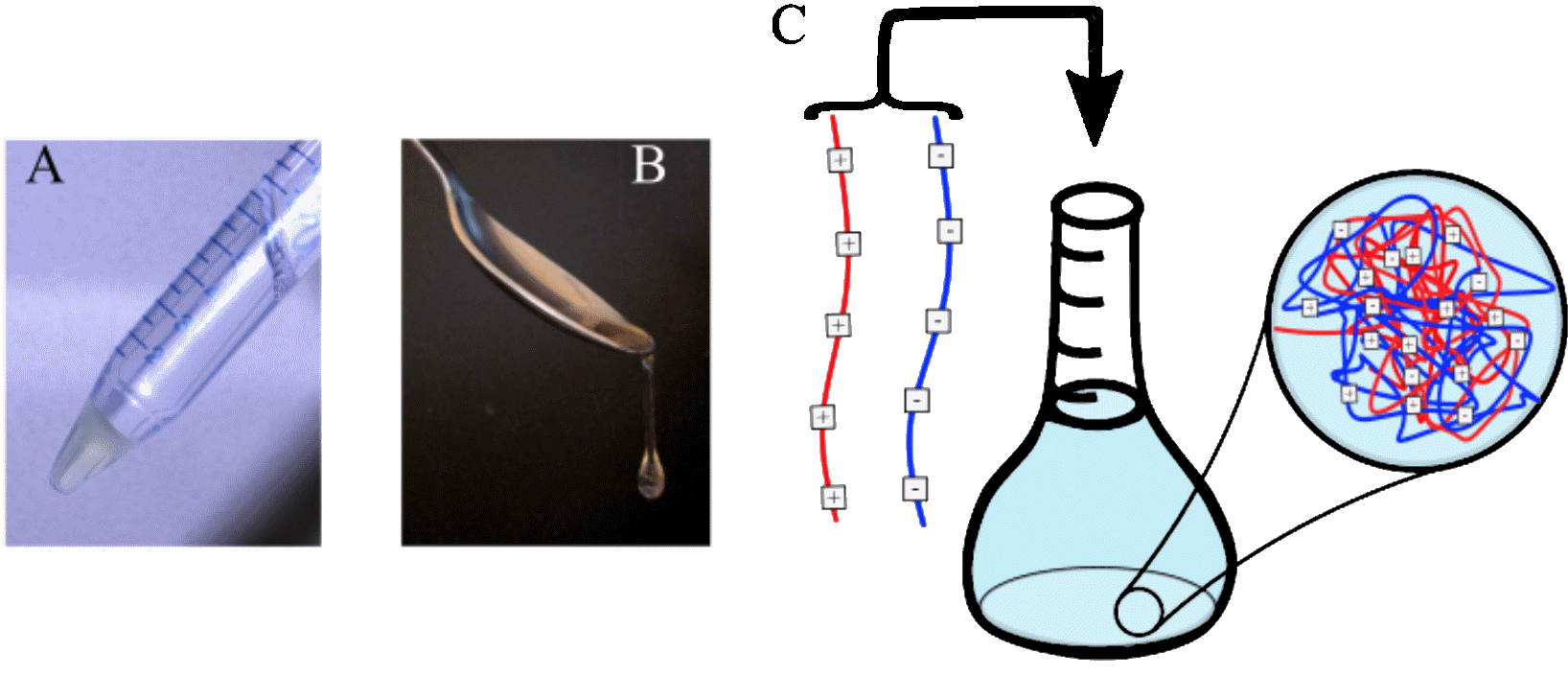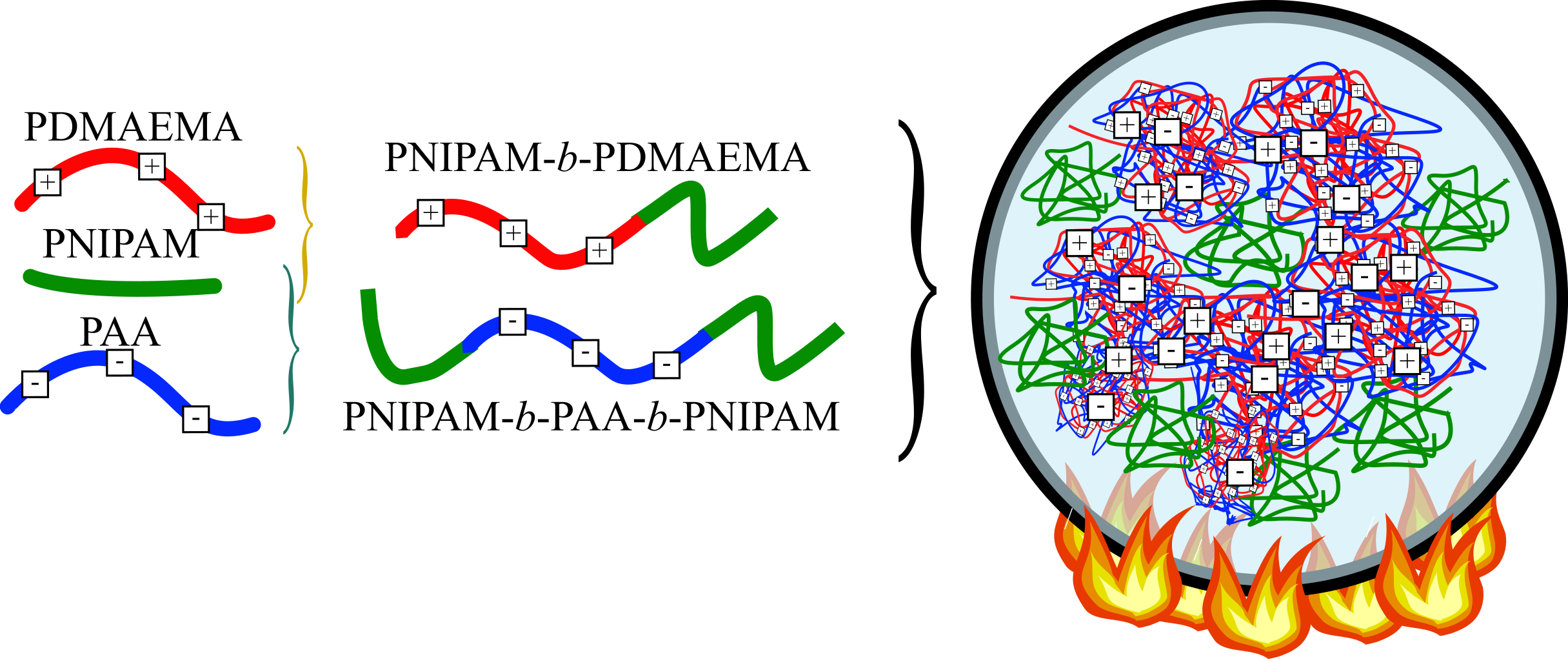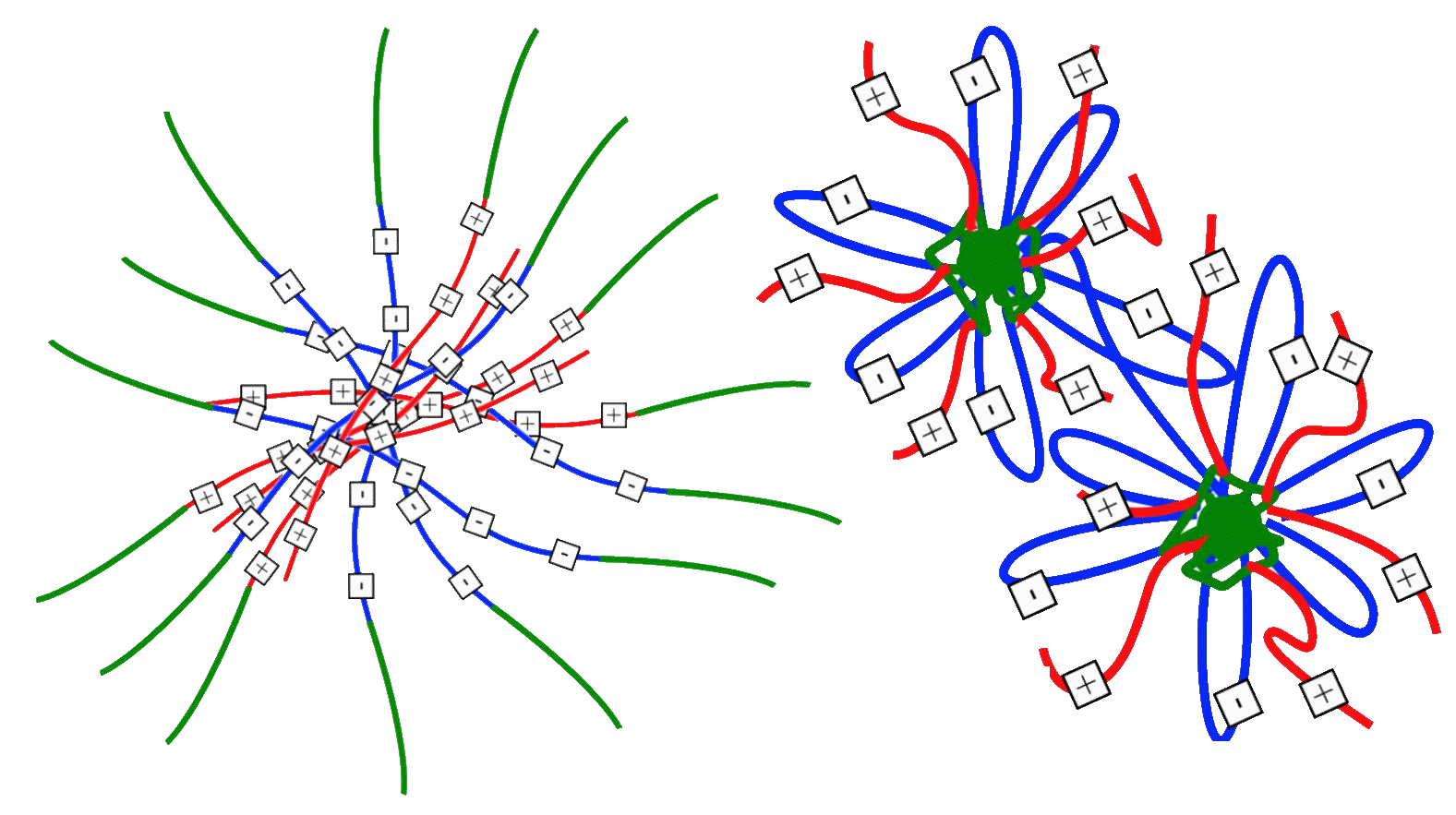MSc Thesis
I performed my MSc thesis in 2016-2017 under supervision of Marleen Kamperman (currently professor at the University of Groningen) and Jasper van der Gucht in the Physical Chemistry and Soft Matter group at Wageningen University.
In this project, I explored the coacervation behaviour of temperature responsive polyelectrolytes. If you want a short(-ish) readable, understandable version of my work, hopefully understandable for laymen, keep reading! Otherwise, go read the paper that was published about this project.
Polymers, Polyelectrolytes, and Coacervation
Before we go any deeper, it is probably best to give you some background on polymers, polyelectrolytes and coacervation. If you know all about this, you may want to skip this section.
A polymer is simply a very long molecule. Many of the things around us are made of polymers: all plastics, but also wood, DNA, and glue are polymeric materials. Almost always a polymer consists of a single ‘monomer’ molecule, which is just repeated a bunch of times in a row, creating a chain. Imagine a string of beads: each bead is a monomer, together forming a polymer. You can of course vary the order of the beads, first adding blue ones, then green ones. Maybe we can vary the shape of the beads as well. The same thing goes with polymers. We can choose the type of monomers we want to make our chain out of, and we can switch to a different type halfway trough, or even make a mix of different beats. Although in chemistry, adding monomers is a bit more complicated then putting a bead on a string, the idea is really very similar.
Now, we can choose a very specific type of bead to build our chains from, one with a charge. If you do this, you no longer call the polymer a polymer, but a polyelectrolyte. Don’t ask me why. You can thus make polymers with a charge. It may be somewhat unsurprising, but when you take a positively charged polyelectrolyte (dissolved in water), and mix it with an negatively charged polyelectrolyte, the polymers tend to attract each other, form little droplets of mixed polyelectrolyte, and sink to the bottom. On the bottom, all the small polymer droplets merge to form a new concentrated phase consisting of both types of polyelectrolytes (positive & negative) and a lot of water (up to 80% water in fact). This process is what we call complex coacervation, and the concentrated phase it produces is called a complex coacervate. The complex coacervate is typically a gooey, slimy substance, that cannot be dissolved in water, despite containing a lot of water.

This complex coacervation takes place between 2 oppositely charged polyelectrolytes, and is not caused by electrostatic effects (meaning the charges attracting each other, as you may expect), but due to the entropic gain of the displacement of counter-ions on the polyelectrolytes. The polyelectrolytes have some salts on them, and when they coacervate, the salts come off, which basically, is something nature likes. This means that the amount and type of salt in the water when you start can strongly influence how strongly the polyelectrolytes bond to each other.
Glue, Complex Coacervates, and a Sandcastle Worm
Now, as I mentioned, a complex coacervate is a somewhat slimy substance, not unlike unset glue. This gives us an idea. Maybe we can use it to make glue?
To make glue (or formally, an adhesive), we want a material with 3 properties:
- Glue must be a cohesive liquid, meaning it should sort of stay together, e.g. it must be sort of slimy
- Glue can be applied to a surface, and spread over the surface covering any roughness or cracks.
- Glue must be able to cure - it must go from its ‘spread over cracks and connect to surfaces’-mode to a strong, hard material that is strongly bonded to the surface somehow. Typically this curing occurs through connecting individual polymers in the glue together, thus forming a strong network. This bonding is often caused by an external trigger, like heat, radiation, or the addition of a second component.
The very nice property of our complex coacervate is that it is indeed a cohesive liquid, which can be applied to a surface, even underwater! Most glues do not work, or hardly work, when in a wet environment. Many people try to make glue for medical purposes: it would be nice to glue an organ back together after surgery, instead of using stitches (for a variety of reasons, but most easy to imagine is the fact that a stitch inherently requires you to poke even more holes in an already damaged person).
So the component we are missing right now is something to cure our coacervate. How can we make our coacervate grow hard due to a trigger we provide? Here we find our inspiration in nature. It turns out that a sandcastle worm already makes coacervate-based adhesives. It uses it to build a small house from sand (hence the name). To cure its coacervates, it uses a pH trigger. (Of course, this is why we started looking into this in the first place, but that would make for a confusing introduction.)
We prefer not to work with pH but with an easier to control variable: temperature. To make our coacervate glue set, we are going to build a two step mechanism: first we have the two polyelectrolytes come together and form a coacervate. This coacervate can be applied to the surface we are trying to glue. Then, we increase the temperature, and another component causes the coacervate to harden out, and things are glued together.
So, how do we go about this, how do we get a temperature controlled hardening? Our solution is PNIPAM, a polymer that is pretty boring and water-soluable at room temperature, but changes it behaviour when it is heated above ~32°C: it demixes from water and starts sticking to itself (this is the so called LCST). Why this happens exactly is at the moment not super relevant, but it is all quite interesting, and worthy of study in its own right. Important to mention here is that if you add salt to the PNIPAM solution, you decrease this LCST, you can go even to below the freezing point if you just keep adding salt!
The solution we have now constructed is, in theory, pretty simple: we make 2 types of special polymers, each made of two parts (so called block-copolymers). The first part of the polymer is charged, either positive or negative, and the second part of the polymer is PNIPAM. In theory, this could react the way we want to, creating a glue that I have described.

Results (and some discussion)
It turns out, things sort of worked the way we expect, only, more is happening then we expected! We get an entire phase diagram of behaviours. It turns out that depending on the salt concentration and the temperature of the samples, you see wildly different things in the polymer mixture. I will guide you trough it quickly.
At very high salt concentrations, the coacervate does not want to form, because the driving force (releasing salt into the solution) is basically gone. But, as you have added a lot of salt, the PNIPAM LCST is below room temperature, and thus all the PNIPAM tries to stick together. This causes the formation of so called PNIPAM cored micelles, basically, you have little balls with a core of PNIPAM from several polymers stuck together, and several strands of charged polymer standing out from that, in such a way that no more PNIPAM can be added to this ball.
At lower salt concentration (but still room temperature), we get so called coacervate cored micelles, the opposite situation of earlier. Now, because the salt concentration is lower, the polyelectrolytes try to stick together to form a coacervate, but the PNIPAM wants to be dissolved in water, because we are below its LCST! This leads to, again, balls, now with a core of coacervate, and a bunch of PNIPAM polymers standing out, making sure not more coacervate can join the ball in the center.

Now, if we start at this low-salt situation and increase the temperature, we cross the LCST of PNIPAM, and it no longer wants to dissolve in water, and tries to find other PNIPAM to stick to. This is what we originally wanted! Everything starts to stick together, leading to a though, solid coacervate falling out of the solution.
Now of course, since this is the stuff we were looking for, we want to do all kinds of tests to see how sticky it is, how strong it is, etc., etc., but, unfortunatly for me, my time was up, my thesis had to be handed in, and thus I did not have time to do any more work. I left it up to my supervisors to finish up, and luckily for me, they did.
There are some more things to say about what phases form and how they behave, but then we must go a bit deeper. I think at that point you are better of just reading the paper about this work if you want to know more, so I won’t go any further here.